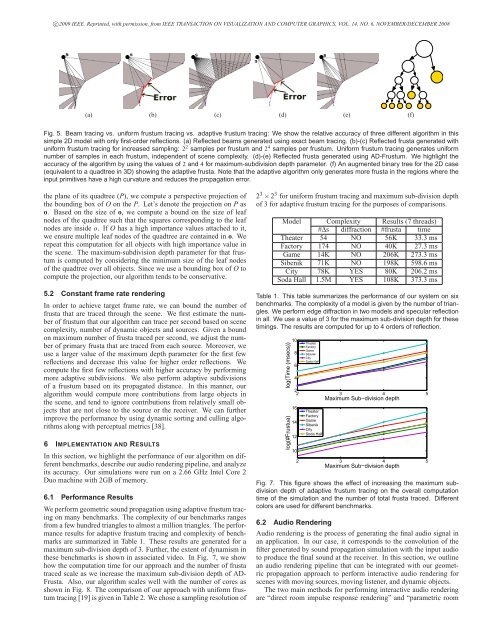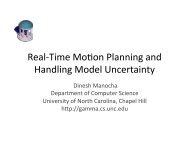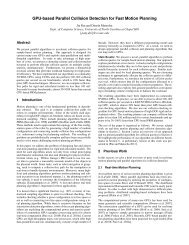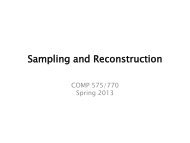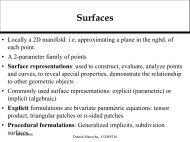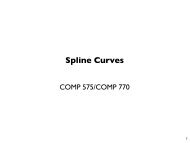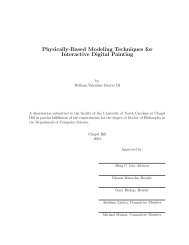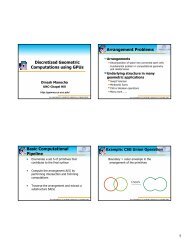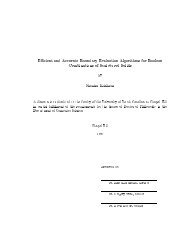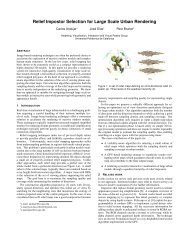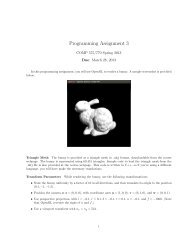Adaptive Frustum Tracing for Interactive Sound Propagation
Adaptive Frustum Tracing for Interactive Sound Propagation
Adaptive Frustum Tracing for Interactive Sound Propagation
You also want an ePaper? Increase the reach of your titles
YUMPU automatically turns print PDFs into web optimized ePapers that Google loves.
c○2009 IEEE. Reprinted, with permission, from IEEE TRANSACTION ON VISUALIZATION AND COMPUTER GRAPHICS, VOL. 14, NO. 6, NOVEMBER/DECEMBER 2008<br />
(a) (b) (c) (d) (e) (f)<br />
Fig. 5. Beam tracing vs. uni<strong>for</strong>m frustum tracing vs. adaptive frustum tracing: We show the relative accuracy of three different algorithm in this<br />
simple 2D model with only first-order reflections. (a) Reflected beams generated using exact beam tracing. (b)-(c) Reflected frusta generated with<br />
uni<strong>for</strong>m frustum tracing <strong>for</strong> increased sampling: 2 2 samples per frustum and 2 4 samples per frustum. Uni<strong>for</strong>m frustum tracing generates uni<strong>for</strong>m<br />
number of samples in each frustum, independent of scene complexity. (d)-(e) Reflected frusta generated using AD-<strong>Frustum</strong>. We highlight the<br />
accuracy of the algorithm by using the values of 2 and 4 <strong>for</strong> maximum-subdivision depth parameter. (f) An augmented binary tree <strong>for</strong> the 2D case<br />
(equivalent to a quadtree in 3D) showing the adaptive frusta. Note that the adaptive algorithm only generates more frusta in the regions where the<br />
input primitives have a high curvature and reduces the propagation error.<br />
the plane of its quadtree (P), we compute a perspective projection of<br />
the bounding box of O on the P. Let’s denote the projection on P as<br />
o. Based on the size of o, we compute a bound on the size of leaf<br />
nodes of the quadtree such that the squares corresponding to the leaf<br />
nodes are inside o. If O has a high importance values attached to it,<br />
we ensure multiple leaf nodes of the quadtree are contained in o. We<br />
repeat this computation <strong>for</strong> all objects with high importance value in<br />
the scene. The maximum-subdivision depth parameter <strong>for</strong> that frustum<br />
is computed by considering the minimum size of the leaf nodes<br />
of the quadtree over all objects. Since we use a bounding box of O to<br />
compute the projection, our algorithm tends to be conservative.<br />
5.2 Constant frame rate rendering<br />
In order to achieve target frame rate, we can bound the number of<br />
frusta that are traced through the scene. We first estimate the number<br />
of frustum that our algorithm can trace per second based on scene<br />
complexity, number of dynamic objects and sources. Given a bound<br />
on maximum number of frusta traced per second, we adjust the number<br />
of primary frusta that are traced from each source. Moreover, we<br />
use a larger value of the maximum depth parameter <strong>for</strong> the first few<br />
reflections and decrease this value <strong>for</strong> higher order reflections. We<br />
compute the first few reflections with higher accuracy by per<strong>for</strong>ming<br />
more adaptive subdivisions. We also per<strong>for</strong>m adaptive subdivisions<br />
of a frustum based on its propagated distance. In this manner, our<br />
algorithm would compute more contributions from large objects in<br />
the scene, and tend to ignore contributions from relatively small objects<br />
that are not close to the source or the receiver. We can further<br />
improve the per<strong>for</strong>mance by using dynamic sorting and culling algorithms<br />
along with perceptual metrics [38].<br />
6 IMPLEMENTATION AND RESULTS<br />
In this section, we highlight the per<strong>for</strong>mance of our algorithm on different<br />
benchmarks, describe our audio rendering pipeline, and analyze<br />
its accuracy. Our simulations were run on a 2.66 GHz Intel Core 2<br />
Duo machine with 2GB of memory.<br />
6.1 Per<strong>for</strong>mance Results<br />
We per<strong>for</strong>m geometric sound propagation using adaptive frustum tracing<br />
on many benchmarks. The complexity of our benchmarks ranges<br />
from a few hundred triangles to almost a million triangles. The per<strong>for</strong>mance<br />
results <strong>for</strong> adaptive frustum tracing and complexity of benchmarks<br />
are summarized in Table 1. These results are generated <strong>for</strong> a<br />
maximum sub-division depth of 3. Further, the extent of dynamism in<br />
these benchmarks is shown in associated video. In Fig. 7, we show<br />
how the computation time <strong>for</strong> our approach and the number of frusta<br />
traced scale as we increase the maximum sub-division depth of AD-<br />
Frusta. Also, our algorithm scales well with the number of cores as<br />
shown in Fig. 8. The comparison of our approach with uni<strong>for</strong>m frustum<br />
tracing [19] is given in Table 2. We chose a sampling resolution of<br />
2 3 × 2 3 <strong>for</strong> uni<strong>for</strong>m frustum tracing and maximum sub-division depth<br />
of 3 <strong>for</strong> adaptive frustum tracing <strong>for</strong> the purposes of comparisons.<br />
Model Complexity Results (7 threads)<br />
#Δs diffraction #frusta time<br />
Theater 54 NO 56K 33.3 ms<br />
Factory 174 NO 40K 27.3 ms<br />
Game 14K NO 206K 273.3 ms<br />
Sibenik 71K NO 198K 598.6 ms<br />
City 78K YES 80K 206.2 ms<br />
Soda Hall 1.5M YES 108K 373.3 ms<br />
Table 1. This table summarizes the per<strong>for</strong>mance of our system on six<br />
benchmarks. The complexity of a model is given by the number of triangles.<br />
We per<strong>for</strong>m edge diffraction in two models and specular reflection<br />
in all. We use a value of 3 <strong>for</strong> the maximum sub-division depth <strong>for</strong> these<br />
timings. The results are computed <strong>for</strong> up to 4 orders of reflection.<br />
log(Time (msecs))<br />
log(#Frustua)<br />
10<br />
8<br />
6<br />
4<br />
Theater<br />
Factory<br />
Game<br />
Sibenik<br />
City<br />
Soda Hall<br />
2<br />
2 3 4 5<br />
Maximum Sub−division depth<br />
16<br />
14<br />
12<br />
10<br />
Theater<br />
Factory<br />
Game<br />
Sibenik<br />
City<br />
Soda Hall<br />
2 3 4 5<br />
Maximum Sub−division depth<br />
Fig. 7. This figure shows the effect of increasing the maximum subdivision<br />
depth of adaptive frustum tracing on the overall computation<br />
time of the simulation and the number of total frusta traced. Different<br />
colors are used <strong>for</strong> different benchmarks.<br />
6.2 Audio Rendering<br />
Audio rendering is the process of generating the final audio signal in<br />
an application. In our case, it corresponds to the convolution of the<br />
filter generated by sound propagation simulation with the input audio<br />
to produce the final sound at the receiver. In this section, we outline<br />
an audio rendering pipeline that can be integrated with our geometric<br />
propagation approach to per<strong>for</strong>m interactive audio rendering <strong>for</strong><br />
scenes with moving sources, moving listener, and dynamic objects.<br />
The two main methods <strong>for</strong> per<strong>for</strong>ming interactive audio rendering<br />
are “direct room impulse response rendering” and “parametric room


